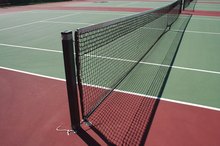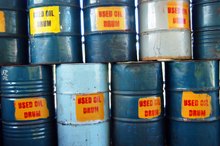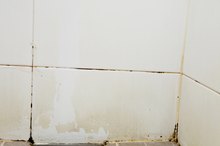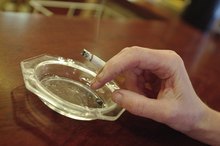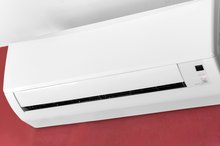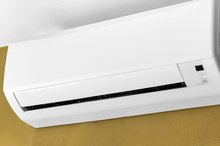Environmentally Friendly Ways to Clean Mold Off Concrete Patios
Indoor and outdoor mold can grow on concrete surfaces like patios and basement floors and walls. When mold appears indoors, it can present a health hazard. Outdoors, mold can mar the appearance of the patio and make the patio surface slick. You should remove this mold quickly, but without negatively affecting the environment.
If you use harsh chemicals outdoors, you can kill plants due to chemicals in the runoff.
Indoors you could impart chemicals into the air 1. There are means to avoid both problems.
Water Pressure
Use a pressure sprayer and pure water to remove mold from concrete indoors and out.
Set the power sprayer on the most effective nozzle setting to blow the mold off the patio. Be aware that a too-concentrated stream can leave a mark on your patio. Indoors, use a power sprayer and a wet vacuum at the same time.
As you blow the mold off the concrete, suck up the wastewater with the vacuum. You can also sweep the water into a nearby sump pump well.
- Use a pressure sprayer and pure water to remove mold from concrete indoors and out.
Safe Chemical Products for Mold Removal
Organic Remedies for Killing Mold
Learn More
Several products are on the market for killing mold and mildew without harsh chemicals. The Environmental Protection Agency has approved Safe Shield and Oxy-Mold. Safe Shield includes an organic component that provides a sealant against re-growth of mold.
Household Products
Borax, bleach, vinegar and ammonia all have the capacity to kill mold on concrete surfaces. Since they are organic chemicals, they will not be as damaging to plants and people if accidental exposure occurs. However, this is only true if you adequately dilute these household products. Bleach and ammonia, if not diluted adequately with water, can cause respiratory irritations. Use a scrub brush to apply the product to the mold in small batches 1. Rinse the area with clean water. Indoors, vacuum the wastewater away. Outdoors, spray the waste away with clean water from a hose.
- Borax, bleach, vinegar and ammonia all have the capacity to kill mold on concrete surfaces.
Steam Cleaning
How to Clean a Tennis Court
Learn More
You can kill mold and remove it from concrete by using a steam cleaner. You can rent steam cleaners normally used for steaming wrinkles out of draperies.
Load water in the steam cleaner and let the machine warm up. Then blast the mold with spurts of hot steam.
**Rinse the area with clean water.
Be careful to wear protective clothing and shoes and avoid direct contact with the steam. ** Steam can produce serious burns on bare skin.
- You can kill mold and remove it from concrete by using a steam cleaner.
Scrubbing and Scouring
You can also kill mold with elbow grease 1.
Use a stiff pig-bristle or metal scrub brush to remove the mold by hand.
You can also use an abrasive-like sand or household scouring powder to help remove mold with a scrub brush. Rinse the area thoroughly with clean water, from either a hose or a spray bottle and sponge.
- You can also kill mold with elbow grease 1.
- Use a stiff pig-bristle or metal scrub brush to remove the mold by hand.
Special Precautions
The wastewater produced after rinsing the surface will contain mold spores. Wear protective rubber gloves and a mouth and nose mask to prevent inhaling these spores.
Keep the area wet to prevent the spores from becoming airborne inside the house. If you are de-molding a large area indoors, seal off any ventilation ducts and doorways to other rooms. Wash your work clothes immediately after finishing the job to kill any spores on your clothing.
- The wastewater produced after rinsing the surface will contain mold spores.
- Keep the area wet to prevent the spores from becoming airborne inside the house.
Related Articles
References
- “The Homeowner's Guide to Mold”; Michael A. Pugliese; 2006
- Amirhosein Ghaffarianhoseini, Husam AlWaer, Hossein Omrany, Ali Ghaffarianhoseini, Chaham Alalouch, Derek Clements-Croome & John Tookey (2018) Sick building syndrome: are we doing enough?. Architectural Science Review,61:3, 99-121.
- American College of Allergy, Asthma & Immunology. Mold Allergy. Reviewed April 23, 2018.
- Centers for Disease Control and Prevention. Fungal Diseases. Reviewed May 6, 2019.
- Centers for Disease Control and Prevention. Mold. Basic Facts. Reviewed December 20, 2017
- Asthma and Allergy Foundation of America. Mold Allergy. Reviewed October 2015.
- Centers for Disease Control and Prevention. Molds in the Environment. Rreviewed December 20, 2017.
- Asthma and Allergy Foundation of America, Mold Allergy
- Centers for Disease Control and Prevention (CDC), Mold, Basic Facts
- Rudert A, Portnoy J.Mold allergy: is it real and what do we do about it?Expert Rev Clin Immunol. 2017 Aug;13(8):823-835. doi: 10.1080/1744666X.2017.1324298. Epub 2017 May 17.
Writer Bio
A writer and entrepreneur for over 40 years, J.E. Myers has a broad and eclectic range of expertise in personal computer maintenance and design, home improvement and design, and visual and performing arts. Myers is a self-taught computer expert and owned a computer sales and service company for five years. She currently serves as Director of Elections for McLean County, Illinois government.

